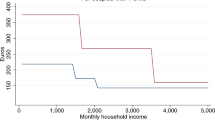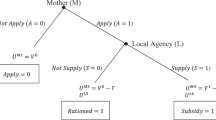Abstract
This study fills an important gap about child care subsidy participation by exploring why parents leave the subsidy program in Oregon. Descriptive analyses using administrative data showed unexpectedly high levels of employment stability and low levels of family mobility. Many families appeared to remain eligible after exit based on earnings and participation in other means-tested assistance programs. Estimates from a Cox regression model showed that subsidy policies were associated with exits. Being in the last month of an eligibility period increased the likelihood of exiting the subsidy program by two to three times. This result suggests that lengthening eligibility period could increase the stability of subsidy usage and possibly subsidized child care arrangements.
Similar content being viewed by others
Notes
We call this a family subsidy spell and define it as continuous receipt of a subsidy for any child in the family. A family spell is distinct from a child spell. A child spell is defined as continuous receipt for an individual child and is typically used in studies focused on child outcomes (e.g., child care arrangement stability). Family subsidy spells are used in this study because our question of interest focuses on parent outcomes. Thus, it was important to capture the spells related to the length of time a parent participates in the subsidy program.
Results using other distributional assumptions and, alternatively, a semi parametric model (Kaplan–Meier) were similar. See Allison (1995) for a description of estimating parametric or accelerated failure time (AFT) models using proc lifereg in SAS.
The Office of Management and Budget defines metropolitan counties to include an urbanized area of 50,000 population or more plus outlying counties with close economic or social ties to the central county. Non-metropolitan counties are divided into two groups: micropolitan and non-core. Micropolitan counties include at least one urban cluster of 10,000–49,000 people, plus outlying counties with strong economic and social relationships to the central county. All other counties are considered non-core.
References
Acs, G., & Loprest, P. (2004). Leaving welfare: Employment and well-being of families that left welfare in the post-entitlement era. Kalamazoo: Upjohn Institute.
Adams, G., Synder, K., & Sandfort, J. R. (2002). Getting and retaining child care assistance: How policy and practice influence parents’ experiences (Research Report No. A-50). Washington: Urban Institute.
Alfred, M. V. (2005). Does Wisconsin works work? Perspectives of participating women and their employers. Journal of Family and Economic Issues, 26(3), 345–370.
Allison, P. D. (1995). Survival analysis using the SAS system. Cary: The SAS Institute.
Blau, D. M., & Robins, P. K. (1991). Turnover in child care arrangements. The Review of Economics and Statistics, 73(1), 152–157.
Blau, D. M., & Robins, P. K. (1998). A dynamic analysis of turnover in employment and child care. Demography, 35(1), 83–96.
Blau, D. M., & Tekin, E. (2001). The determinants and consequences of child care subsidy program receipt by low-income families. (Joint Center for Poverty Research) Retrieved September 6, 2007, from http://www.jcpr.org/book/pdf/IncentivesBlauChap10.pdf
Bok, M., & Simmons, L. (2002). Post-welfare reform, low-income families and the dissolution of the safety net. Journal of Family and Economic Issues, 23(3), 217–238.
Burstein, N., Layzer, J., Cahill, K., Werner, A., & McGarry, N. National study of child care of low-income families: Patterns of child care use among low-income families. Cambridge, MA: Abt Associates (forthcoming).
Collins, A., Layzer, J., Kreader, J. L., Werner, A., & Glantz, F. (2000). National study of child care for low-income families: State and community substudy interim report. Cambridge: Abt Associates.
Currie, J. (2006). The take-up of social benefits. In A. Auerback, D. Card, & J. Quigley (Eds.), Poverty, the distribution of income and public policy (pp. 80–148). New York: Russell Sage.
Grobe, D., Weber, R. A., & Pratt, C. C. (2006). 2006 Oregon child care market rate study (Technical Report). Corvallis: Oregon State University, Family Policy Program.
Hofferth, S. L., Brayfield, A., Deich, S., & Holcomb, P. (1991). National child care survey, 1990 (Urban Institute Report 91–5). Washington: The Urban Institute Press.
Hofferth, S. L., & Collins, N. (2000). Child care and employment turnover. Population Research and Policy Review, 19, 357–395.
Huston, A. C., Chang, Y. E., & Gennetian, L. (2002). Family and individual predictors of child care use by low-income families in different policy contexts. Early Childhood Research Quarterly, 17, 441–469.
Lee, B. J., Goerge, R., Reidy, M., Kreader, J. L., Georges, A., Wagmiller, R. L., Jr., Stavely, J., Stevens, D., & Witte, A. (2004). Child care subsidy use and employment outcomes of TANF mothers during the early years of welfare reform: A three-state study. Chicago: The University of Chicago, Chapin Hall Center for Children.
Loeb, S., Fuller, B., Kagan, S. L., & Carrol, B. (2004). Child care in poor communities: Early learning effects of type, quality, and stability. Child Development, 75(1), 47–65.
Meyers, M. K. (1997). Cracks in the seams: Durability of child care in JOBS welfare-to-work programs. Journal of Family and Economics Issues, 18(4), 379–406.
Meyers, M. K., & Heintze, T. (1999). The performance of the child-care subsidy system. Social Service Review, 73(1), 37–64.
Meyers, M. K., Peck, L. R., Davis, E. E., Collins, A., Kreader, J. L., Georges, A., Weber, R., Schexnayder, D. T., Schroeder, D. G., & Olson, J. A. (2002). The dynamics of child care subsidy use: A collaborative study of five states. New York: National Center for Children in Poverty.
Miller, C. (2003). Stability and change in child care and employment: Evidence from three states (MDRC Working Paper Series No. 20). New York: MDRC.
Mills, B., Sundar, D., Peterson, E., & Alwang, J. (2001). Determinants of food stamp program exits. Social Service Review, 75(4), 539–558.
Moffitt, R. (1983). An economic model of welfare stigma. American Economic Review, 73(5), 1023–1035.
Schaefer, S. A., Kreader, J. L., & Collins, A. M. (2005). Predictors of child care subsidy use. Research connections. Retrieved September 6, 2007, from http://www.childcareresearch.org/location/ccrca7459.
Schulman, K., & Blank, H. (2005). Child care assistance policies 2005: States fail to make up lost ground, families continue to lack critical supports. Washington: National Women’s Law Center.
Shlay, A., Weinraub, M., Harmon, M., & Tran, H. (2004). Barriers to subsidies: Why low-income families do not use child care subsidies. Social Science Research, 33, 134–157.
Simmons, L. A., Braun, B., Wright, D. W., & Miller, S. R. (2007). Human capital, social support, and economic well-being among rural, low-income mothers: A latent growth curve analysis. Journal of Family and Economics Issues, 28(4), 635–652.
Urban, J. A., & Olson, P. N. (2005). A comprehensive employment model for low-income mothers. Journal of Family and Economic Issues, 26(1), 101–122.
Witte, A. D., & Queralt, M. (2003). Impacts of eligibility expansions and provider reimbursement rate increases on child care subsidy take-up rates, welfare use and work (NBER Working Paper No. 9693). Cambridge: National Bureau of Economic Research.
Acknowledgments
This Report was supported by the federal Child Care Bureau of the U.S. Department of Health and Human Services’ Administration for Children and Families, Administration on Children, Youth and Families under Grant Number 90YE0040. The views expressed are those of the authors and not necessarily those of the federal Child Care Bureau.
Author information
Authors and Affiliations
Corresponding author
Rights and permissions
About this article
Cite this article
Grobe, D., Weber, R.B. & Davis, E.E. Why Do They Leave? Child Care Subsidy Use in Oregon. J Fam Econ Iss 29, 110–127 (2008). https://doi.org/10.1007/s10834-007-9094-3
Published:
Issue Date:
DOI: https://doi.org/10.1007/s10834-007-9094-3




